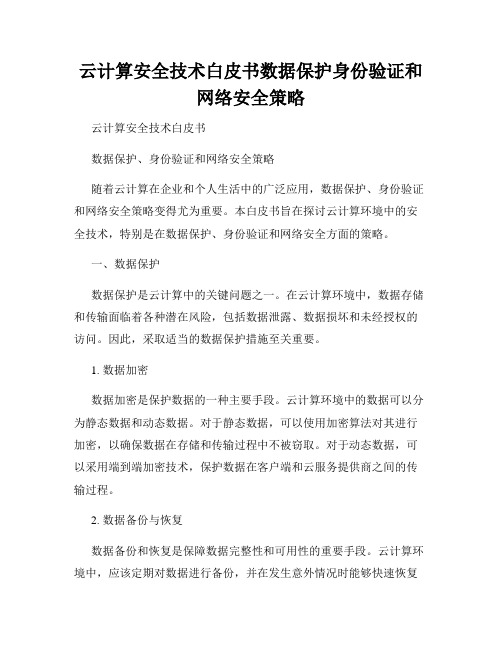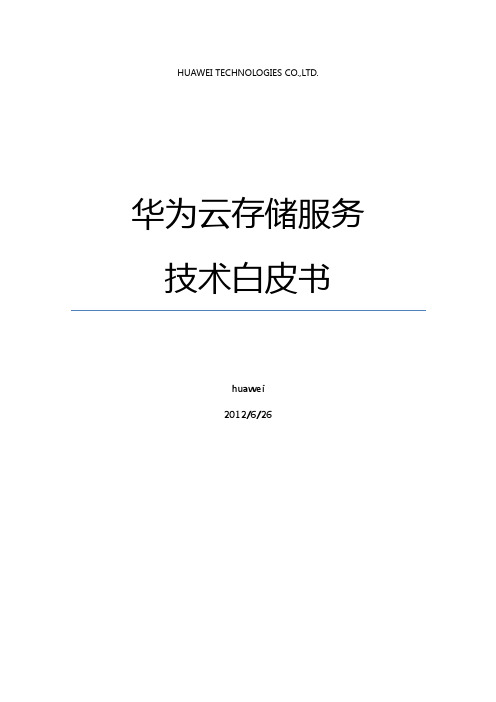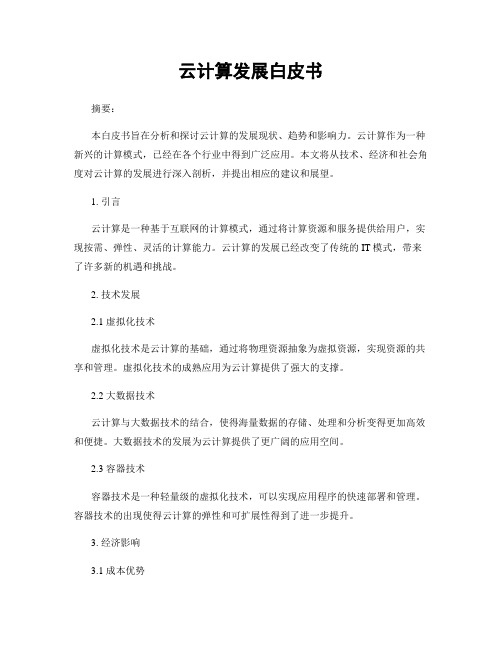迷你云网盘技术白皮书
云游戏技术白皮书(2020

目录缩略语 (3)1.云游戏的概念 (4)1.1云游戏的定义 (4)1.2云游戏的分类 (4)1.3云游戏的特征 (5)1.3.1对终端硬件配置的要求降低 (5)1.3.2对云服务器性能和传输网络的要求提升 (6)1.3.3有利于简化审批和内容管控 (6)2.云游戏的发展状况 (7)2.1国际云游戏市场发展状况 (7)2.2国内云游戏市场发展状况 (7)2.3云游戏产业发展机遇与挑战 (8)2.3.1机遇 (8)2.3.2挑战 (9)3.云游戏关键技术 (11)3.1云计算 (11)3.2GPU (11)3.35G (12)3.4边缘计算 (12)3.5视频编解码 (13)4.云游戏端到端解决方案 (14)4.1系统组成 (14)4.2云端服务系统 (15)4.2.1流化能力 (16)4.2.2应用交付 (17)4.2.3业务服务 (18)4.3传输网络 (20)4.4终端系统 (20)4.5安全与管理 (21)4.5.1云游戏系统安全 (21)4.5.2云游戏未成年人防沉迷 (21)4.5.3云游戏版权保护 (21)4.5.4云游戏隐私保护 (22)5.云游戏应用案例 (23)5.1应用案例1 (23)5.2应用案例2 (24)5.3应用案例3 (26)5.4应用案例4 (27)5.5应用案例5 (27)6.云游戏应用展望 (31)参考文献 (32)缩略语缩略语英文全称中文全称PC Personal Computer个人计算机VR Virtual Reality虚拟现实GPU Graphics Processing Unit图形处理器AR Augmented Reality增强现实FPS Frame Per Second画面每秒传输帧数IDC Internet Data Center互联网数据中心SOC System on Chip片上系统SLA Service-Level Agreement服务级别协议CDN Content Delivery Network内容分发网络IaaS Infrastructure as a Service基础设施即服务PaaS Platform as a Service平台即服务SaaS Software as a Service软件即服务TPS Transaction Per Second每秒事务处理量SDK Software Development Kit软件开发工具包1.云游戏的概念1.1云游戏的定义云游戏是以云计算为基础的游戏方式,本质上为交互性的在线视频流,在云游戏的运行模式下,游戏在云端服务器上运行,并将渲染完毕后的游戏画面或指令压缩后通过网络传送给用户。
云计算安全技术白皮书数据保护身份验证和网络安全策略

云计算安全技术白皮书数据保护身份验证和网络安全策略云计算安全技术白皮书数据保护、身份验证和网络安全策略随着云计算在企业和个人生活中的广泛应用,数据保护、身份验证和网络安全策略变得尤为重要。
本白皮书旨在探讨云计算环境中的安全技术,特别是在数据保护、身份验证和网络安全方面的策略。
一、数据保护数据保护是云计算中的关键问题之一。
在云计算环境中,数据存储和传输面临着各种潜在风险,包括数据泄露、数据损坏和未经授权的访问。
因此,采取适当的数据保护措施至关重要。
1. 数据加密数据加密是保护数据的一种主要手段。
云计算环境中的数据可以分为静态数据和动态数据。
对于静态数据,可以使用加密算法对其进行加密,以确保数据在存储和传输过程中不被窃取。
对于动态数据,可以采用端到端加密技术,保护数据在客户端和云服务提供商之间的传输过程。
2. 数据备份与恢复数据备份和恢复是保障数据完整性和可用性的重要手段。
云计算环境中,应该定期对数据进行备份,并在发生意外情况时能够快速恢复数据。
备份数据应存储在不同的地理位置,以防止因灾难性事件导致的数据丢失。
二、身份验证在云计算环境中,身份验证是保护数据和系统安全的关键环节。
只有经过身份验证的用户才能访问云计算资源和数据。
因此,有效的身份验证机制对于确保系统的安全至关重要。
1. 单因素身份验证传统的单因素身份验证包括使用用户名和密码进行登录。
但是,这种身份验证方式存在安全性较低的问题,容易遭受密码泄露和密码猜测的风险。
对于敏感数据和关键系统,应该采用更加安全的身份验证方式,如多因素身份验证。
2. 多因素身份验证多因素身份验证是指在用户登录过程中使用两个或多个独立的身份验证要素进行验证,如使用密码和指纹、密码和手机验证码等。
通过多因素身份验证,可以提高系统的安全性,有效防止未经授权的访问。
三、网络安全策略在云计算环境中,网络安全策略的制定和执行是确保系统安全的重要措施。
以下是一些常用的网络安全策略:1. 防火墙和入侵检测系统通过设置防火墙和入侵检测系统,可以监控和过滤网络流量,及时发现和阻止潜在的网络攻击。
云计算技术白皮书

云计算技术白皮书摘要:本白皮书旨在介绍云计算技术的基本概念、原理和应用,并深入探讨其在现代工程领域中的重要性和影响。
通过对云计算技术的综合分析和评估,我们将展示其在提高效率、降低成本、增强数据安全性和促进创新方面的巨大潜力。
此外,我们还将探讨云计算技术在工程领域中的具体应用案例,并提出未来发展方向的建议。
1. 引言随着信息技术的迅速发展,云计算技术已经成为现代工程领域中不可或缺的一部分。
云计算技术不仅提供了强大的计算和存储能力,还为企业和个人提供了灵活的资源调配和高效的数据管理方式。
本章将介绍云计算技术的基本概念和原理,并探讨其在工程领域中的重要性。
2. 云计算技术概述2.1 云计算的定义云计算是一种基于互联网的计算模式,通过将计算资源(包括计算能力、存储空间和网络带宽等)集中管理和提供,使用户能够根据需求快速获取所需资源。
2.2 云计算的基本原理云计算基于虚拟化技术,通过将物理资源抽象为虚拟资源,实现对资源的灵活调配和管理。
云计算还依赖于分布式计算和大数据处理技术,以满足用户对高性能计算和大规模数据处理的需求。
3. 云计算技术在工程领域中的应用3.1 提高工程效率云计算技术为工程领域提供了强大的计算能力和存储空间,使得工程师可以更快速地进行复杂计算和仿真分析。
通过云计算技术,工程师可以在短时间内完成大规模的计算任务,极大地提高了工作效率。
3.2 降低成本云计算技术允许用户按需使用计算资源,避免了传统的硬件投资和维护成本。
工程领域中的企业和个人可以通过使用云计算服务,将大部分的计算和存储任务外包给云服务提供商,从而降低了成本。
3.3 增强数据安全性云计算技术提供了高级的数据备份和恢复机制,可以保障工程领域中的重要数据的安全性。
云服务提供商通常采用多重备份和加密技术,防止数据丢失和被非法访问。
3.4 促进工程创新云计算技术为工程师提供了便捷的开发和测试环境,使得他们可以更快速地开发和部署新的工程产品和解决方案。
SF技术白皮书v2

技术白皮书Symantec Storage Solution™ V4STORAGE SOLUTION存储及高可用解决方案(VERSION: GA 2.0)概述:VERITAS虚拟化产品优化存储架构 (4)1. Qoss (5)1.1 当今的在线存储 (5)1.1.1 技术选择 (5)1.1.2 新一类磁盘阵列 (5)1.1.3 问题综述 (5)1.2传统的文件管理策略 (6)1.2.1 文件系统和存储设备 (6)1.2.2 多个文件系统的局限性 (6)1.2.3 更微妙的影响:在文件系统中不同的数据类型 (7)1.3 VERITAS Storage Foundation多卷文件系统 (7)1.3.1 VERITAS卷管理器 (7)1.3.2 VxVM卷组 (8)1.4 在多卷文件系统中的文件位置 (9)1.4.1 定义数据分配策略并使之与卷相结合 (9)1.4.2 采取策略将元数据从用户数据中分离 (10)1.4.3 多用户数据卷 (11)1.4.4 为文件系统日志分配卷 (11)1.4.5 在多卷文件系统中管理存储空间 (12)1.5 在多卷文件系统中控制存储分配 (12)1.5.1 控制文件位置 (13)1.5.2 控制文件组的定位 (13)1.6 文件重定位 (14)1.6.1 文件重定位标准 (15)1.6.2 定义文件重定位策略 (15)1.6.3 对重定位文件造成影响的分析 (18)1.6.4 自动文件重定位 (19)1.7 分配策略和存储检查点 (20)1.8 封装卷 (21)1.9 QoSS带来的好处 (21)1.10 应用——特殊的文件重定位 (22)1.11 结论 (23)2 Storage Checkpoint:为用户和管理员准备的“回滚”键 (24)2.1 概述 (24)2.2 存储检查点 (24)2.2.1 业务优势 (24)2.2.2 技术优势 (24)2.3 存储检查点最佳运用实例一览 (25)2.3.1 可用性 (25)2.3.2 安装 (25)2.3.3 命名 (25)2.3.4 空间管理 (25)2.3.5 加载 (25)2.3.6集群 (25)2.4 结论 (25)2.5 附录 (25)2.5.1 使用检查点 (25)2.5.2用于检查点管理的Perl Script程序(与cron同时使用) (26)3 Portable Data Container:在异构平台之间共享数据 (33)3.1 VERITAS 可迁移数据容器 (33)3.2 Oracle可迁移表空间 (34)3.3 利用VERITAS PDC操纵Oracle可迁移表空间 (34)3.3.1 自包含数据集合 (34)3.4 生成Oracle可传送数据集合 (34)3.4.1 转换字节顺序 (34)3.4.2 传送数据 (34)3.4.3 提取目标数据库系统 (35)3.5 总结 (35)4 Storage Foundation For Database:数据库存储性能解决方案 (36)4.1 灵活的存储基础架构 (36)4.1.1 VERITAS 企业管理员控制台 (36)4.1.2 自动优化数据库读写Direct I/O (36)4.1.3 动态多路径 (36)4.2 数据库加速 (36)4.3 数据库文件迁移 (36)4.3.1 存储服务的质量 (37)4.3.2 在线存储迁移 (37)4.4(Extent-Based)的存储空间分配 (37)4.5 脱机处理 (37)4.6存储映射 (37)4.7 解决真实世界的性能问题 (39)4.8总结 (44)5 FlashSnap:基于“卷”的跨平台快照技术 (45)6 Intelligent Storage Provisioning(ISP):自动化的存储管理 (46)7 成功案例 (47)概述:VERITAS虚拟化产品优化存储架构IT技术的不断创新和提高可以推动业务的发展。
云安全架构白皮书说明书

EXECUTIVE SUMMARYCompanies are increasingly moving data and applications to public cloud platforms.Sometimes these transitions happen with IT’s approval and guidance; sometimesthey don’t. Regardless, a company that stores data and uses applications in multiplepublic clouds creates a challenging environment for the security architect. It’s difficultto gain visibility and control of the security posture when the organization relies on anassortment of disparate cloud platforms that all take different approaches to securityand offer different tools. And it’s hard for a small security staff to stay on top ofdisparate solutions that fail to integrate.EXPLOSION OF THE ENTERPRISE CLOUDAs the popularity of public cloud platforms like Amazon Web Services (AWS), MicrosoftAzure, and Google Cloud increases, more and more companies are moving their data off-premises for two key reasons. First, the pay-as-you-go cost structure is easier to justify, atleast up front, than the large capital expenditures required to stock an in-house data centeror build a private cloud. And second, companies appreciate the operational agility thatcomes with ramping up capacity at a moment’s notice or shutting off unnecessary featureson demand.1One recent study finds that 80% of companies expect to have more than 10% of theirworkloads on public cloud platforms within three years.2 This is borne out by spendingforecasts as well. IDC recently projected that over the course of 2018, worldwide spendingon public cloud services and infrastructure will reach $160 billion—a 23.2% increase over2017. And by 2021, public cloud spending is forecast to reach $277 billion.3These investments are enabling companies to make crucial applications easier and morecost-effectively available to employees, customers, suppliers, and other stakeholdersaround the world. But public clouds demand particular attention from IT security managersfor the following three reasons:HOW THE RAPID ADOPTION OF PUBLIC CLOUDS ISAFFECTING CYBERSECURITY23.2% projected growth in worldwide spending on public cloud services and infrastructure in 2018.4Security Concerns Need to Be Front and Center3. CLOUD HETEROGENEITY ADDS TO COMPLEXITY AND WORKFLOWSA company with a significant number of cloud services and applications must manage a broad set of heterogeneous technology infrastructures. Employees who can deploy applications themselves to solve a variety of different problems inevitably choose different solutions, from different providers, for different areas of the company.Security capabilities and management interfaces vary across different cloud services, so diversity of solutions further complicates the challenge to create a security architecture that is all-encompassing. Add to that the perpetual disorder caused as business groups are trying and deploying new cloud services and applications, and the challenge of the security architect increases further. Thus, even if shadow IT wasnot an issue and the cybersecurity team was aware of every application in the company’s cloud infrastructure, this constant churn in cloud applications creates an information security dynamic that is hard to track and manage. Further, maintaining a consistent security policy across all a company’s public cloud resources, inventorying security options, and selected settings within each application requires an extraordinary amount of manual effort and expertise.But cybersecurity teams are already stretched and there is an acute security skills shortage—1 million unfilled openings today that is expected to reach 3.5 million in a few years.11 Indeed, more than half of organizations indicate they have a shortage of cybersecurity skills right now.12Still, most companies can’t effectively block their employees’ use of applications and data in the public cloud. Here, the security architect needs to deploy tools and develop processes that facilitate the collection of complete information about the location and security of corporatedata assets, whether on-premises or in a private or public cloud.MUL TIPLE CLOUDS EXPONENTIALL Y INCREASE THE A TT ACK SURFACEWith statistics like these hanging over their heads, security architects are trying to secure a nebulous and ever-expanding public cloud environment. Corporate security is only as strong as the weakest link, and in a diverse cloud infrastructure, each provider has different vulnerabilities.In this case, different public cloud providers have different policies for connecting elements of different applications. Others offer different security solutions. For example, some offer only a network firewall and make customers responsible for any security beyond the perimeter gateway. Others also provide web application firewalls and security information and event management (SIEM) technologies.This is problematic because when applications use application programming interfaces (APIs) or other connectors to share data, a vulnerability in one public cloud application puts the interconnected applications at risk as well. A hacker need only breach one of the cloud-based applications to attack applications throughout the enterprise IT infrastructure. Thus, sharing corporate data in the publiccloud dramatically expands the organization’s attack surface.CLOUD SECURITY CHALLENGES ST ART WITH ARCHITECTUREThe Cloud Security Alliance identifies the top 12 threats to cloud security as:nn Data breachesnn Insufficient identity, credential, and access managementn Insecure interfaces and APIsnnn System vulnerabilitiesn Account hijackingnn Malicious insidersnn Advanced persistent threatsnnn Data lossn Insufficient due diligencenn Abuse and nefarious use of cloud servicesnn Denial of service (DoS)nn Shared technology vulnerabilities26nThese are the threats that keep security architects up at night. Integration among different public clouds is difficult. The ever-expanding corporate attack surface reduces visibility into threats and vulnerabilities for both the IT team and its internal customers. And lack of integration leads to an unnecessarily large number of manual workflows, which presents resource challenges for security teams facing tight budgets and staffing.In addition, sharing of threat intelligence among solutions cannot be automated, so proactive risk management may be nearly impossible. To overcome these challenges, the security architect needs a cloud-centric mindset and the help of cloud security technologies thatintegrate tightly and automate as many processes as possible.Copyright © 2018 Fortinet, Inc. All rights reserved. Fortinet , FortiGate , FortiCare and FortiGuard , and certain other marks are registered trademarks of Fortinet, Inc., and other Fortinet names herein may also be registered and/or common law trademarks of Fortinet. All other product or company names may be trademarks of their respective owners. Performance and other metrics contained herein were attained in internal lab tests under ideal conditions, and actual performance and other results may vary. Network variables, different network environments and other conditions may affect performance results. Nothing herein represents any binding commitment by Fortinet, and Fortinet disclaims all warranties, whether express or implied, except to the extent Fortinet enters a binding written contract, signed by Fortinet’s General Counsel, with a purchaser that expressly warrants that the identified product will perform according to certain expressly-identified performance metrics and, in such event, only the specific performance metrics expressly identified in such binding written contract shall be binding on Fortinet. For absolute clarity, any such warranty will be limited to performance in the same ideal conditions as in Fortinet’s internal lab tests. Fortinet disclaims in full any covenants, representations, and guarantees pursuant hereto, whether express or implied. Fortinet reserves the right to change, modify, transfer, or otherwise revise this publication without notice, and the most current version of the publication shall be applicable. Fortinet disclaims in full any covenants, representations, and guarantees pursuant hereto, whether express or implied. Fortinet reserves the right to change, modify, transfer, or otherwise revise this publication without notice, and the most current version of the publication shall be applicable.GLOBAL HEADQUARTERSFortinet Inc.899 Kifer RoadSunnyvale, CA 94086United StatesTel: +1.408.235.7700/sales EMEA SALES OFFICE 905 rue Albert Einstein 06560 Valbonne France Tel: +33.4.8987.0500APAC SALES OFFICE 8 Temasek Boulevard #12-01Suntec Tower Three Singapore 038988Tel: +65-6395-7899Fax: +65-6295-0015LATIN AMERICA HEADQUARTERS Sawgrass Lakes Center 13450 W. Sunrise Blvd., Suite 430Sunrise, FL 33323Tel: +1.954.368.9990September 24, 2018 2:47 PM1Alex Lesser, “The Cloud Vs. In-house Infrastructure: Deciding Which Is Best For Your Organization ,” Forbes, July 25, 2017.2Arul Elumalai, James Kaplan, Mike Newborn, and Roger Roberts, “Making a secure transition to the public cloud ,” McKinsey & Company, January 2018.3“Worldwide Public Cloud Services Spending Forecast to Reach $160 Billion This Year, According to IDC ,” IDC, January 18, 2018.4Ibid.5Sally Johnson, “Cloud providers can enable ‘self-service’ IT with a cloud portal ,” TechTarget, accessed Sept 13, 2018.6Paul Korzeniowski, “Following both sides of the decentralized vs. centralized IT debate ,” TechTarget, accessed Sept 13, 2018.7Peter Bendor-Samuel, “How to eliminate enterprise shadow IT,” CIO, April 11, 2017.8“OWASP Top Ten Cheat Sheet ,” OWASP , accessed September 14, 2018.9 Malena Carollo, “National Credit Federation exposed 40,000 customers’ finance data ,” Tampa Bay Times, December 6, 2017.10 Girish Sharma, “Why More than 50% of Cloud Deployments Today are Hybrid ,” Netmagic Solutions blog, September 6, 2017.11 Steve Morgan, “Cybersecurity Jobs Reports 2018-2021,” Cybersecurity Ventures, May 31, 2017.12 Jon Oltsik, “Research suggests cybersecurity skills shortage is getting worse ,” CSO, January 11, 2018.13 Michael Kassner, “How to manage cloud security when providers and customers share responsibility ,” TechRepublic, August 19, 2018.14 Robert Bond, “25% of Public Cloud Users Experienced Data Theft ,” SecureOps, June 15, 2018.15 Torsten George, “Compromised Credentials: The Primary Point of Attack for Data Breaches ,” SecurityWeek, January 24, 2018.16 David Egts, “Public cloud security doesn’t end with the cloud provider ,” GCN, February 20, 2018.17 Ibid.18 Ibid.19 Alex Lesser, “The Cloud Vs. In-house Infrastructure: Deciding Which Is Best For Your Organization ,” Forbes, July 25, 2017.20 Robert Bond, “25% of Public Cloud Users Experienced Data Theft ,” SecureOps, June 15, 2018.21 Adam Marre, “Shadow IT: Every Company’s 3 Hidden Security Risks ,” Dark Reading, August 7, 2018.22 Robert Bond, “25% of Public Cloud Users Experienced Data Theft ,” SecureOps, June 15, 2018.23 Adam Marre, “Shadow IT: Every Company’s 3 Hidden Security Risks ,” Dark Reading, August 7, 2018.24 Debasish Pramanik, “What is Shadow IT? Necessity & Its Impact on Enterprise Security ,” CloudCodes, October 25, 2017.25 Ibid.26Bob Violino, “The dirty dozen: 12 top cloud security threats for 2018,” CSO, January 5, 2018.。
云存储服务技术白皮书(终)

HUAWEI TECHNOLOGIES CO.,LTD.华为云存储服务技术白皮书huawei2012/6/26目录1 华为云存储服务介绍 (5)1.1 简介 (5)1.2 服务定位 (5)2 华为云存储应用场景 (6)2.1 网盘服务 (6)2.2 互联网海量数据存储 (7)2.3 数据备份/容灾 (8)2.4 数据归档 (9)2.5 BigData/HPC (9)3 华为云存储服务概念及功能介绍 (11)3.1 云存储基本概念 (11)3.1.1 对象(Objects) (11)3.1.2 存储空间 (12)3.1.3 REST接口 (12)3.2 云存储功能 (12)3.3 访问权限控制 (13)3.4 线下大数据量导入/导出服务 (14)3.5 对象的版本化管理 (15)3.6 可定制的日志服务 (15)4 华为云存储服务特点 (16)4.1 易用性 (16)4.2 高扩展性 (16)4.3 高可靠性 (17)4.3.1 数据可靠性 (17)4.3.2 数据校验 (18)4.3.3 数据自动修复 (18)4.4 高可用性 (19)4.4.1 网络级可靠性设计............................................... 错误!未定义书签。
4.4.2 节点可靠性设计 (19)4.4.3 进程可靠性设计 (19)4.5 高性能 (19)4.5.1 并发访问性能 (20)4.5.2 吞吐能力 (20)4.6 安全性 (20)4.6.1 软件控制安全 (20)4.6.2 数据分块存储(暂未实现) (21)4.7 易管理性 (21)4.8 按需计费 (21)5 华为云存储服务结构简介 (22)5.1 华为云存储服务框架简介 (22)5.2 UDS结构简介 (23)5.2.1 UDS系统结构描述 .............................................. 错误!未定义书签。
FusionSphere存储虚拟化技术白皮书

华为FusionSphere存储虚拟化技术白皮书目录1 执行摘要/Executive Summary (1)2 简介/Introduction (2)3 解决方案/Solution (3)3.1 FusionSphere 存储虚拟化解决方案 (3)3.1.1 架构描述 (3)3.1.2 特点描述 (4)3.2 存储虚拟化的磁盘文件解决方案 (4)3.2.1 固定磁盘技术 (4)3.2.2 动态磁盘技术 (5)3.2.3 差分磁盘技术 (5)3.3 存储虚拟化的业务管理解决方案 (6)3.3.1 磁盘文件的写时重定向技术 (6)3.3.2 磁盘文件的存储热迁移 (6)3.3.3 磁盘文件高级业务 (7)3.4 存储虚拟化的数据存储扩容解决方案 (7)3.4.1 功能设计原理 (7)3.5 存储虚拟化的数据存储修复解决方案 (8)3.5.1 功能设计原理 (8)1 执行摘要/Executive Summary华为提供基于主机的存储虚拟化功能,用户不需要再关注存储设备的类型和能力。
存储虚拟化可以将存储设备进行抽象,以逻辑资源的方式呈现,统一提供全面的存储服务。
可以在不同的存储形态,设备类型之间提供统一的功能。
2 简介/Introduction存储设备的能力、接口协议等差异性很大,存储虚拟化技术可以将不同存储设备进行格式化,将各种存储资源转化为统一管理的数据存储资源,可以用来存储虚拟机磁盘、虚拟机配置信息、快照等信息。
用户对存储的管理更加同质化。
虚拟机磁盘、快照等内存均以文件的形式存放在数据存储上,所有业务操作均可以转化成对文件的操作,操作更加直观、便捷。
基于存储虚拟化平台提供的众多存储业务,可以提高存储利用率,更好的可靠性、可维护性、可以带来更好的业务体验和用户价值。
3 解决方案/Solution3.1 FusionSphere 存储虚拟化解决方案FusionSphere存储虚拟化平台能够屏蔽存储设备差异,统一封装为文件级操作接口,并在虚拟化层提供了丰富的存储业务功能。
云计算发展白皮书

云计算发展白皮书摘要:本白皮书旨在分析和探讨云计算的发展现状、趋势和影响力。
云计算作为一种新兴的计算模式,已经在各个行业中得到广泛应用。
本文将从技术、经济和社会角度对云计算的发展进行深入剖析,并提出相应的建议和展望。
1. 引言云计算是一种基于互联网的计算模式,通过将计算资源和服务提供给用户,实现按需、弹性、灵活的计算能力。
云计算的发展已经改变了传统的IT模式,带来了许多新的机遇和挑战。
2. 技术发展2.1 虚拟化技术虚拟化技术是云计算的基础,通过将物理资源抽象为虚拟资源,实现资源的共享和管理。
虚拟化技术的成熟应用为云计算提供了强大的支撑。
2.2 大数据技术云计算与大数据技术的结合,使得海量数据的存储、处理和分析变得更加高效和便捷。
大数据技术的发展为云计算提供了更广阔的应用空间。
2.3 容器技术容器技术是一种轻量级的虚拟化技术,可以实现应用程序的快速部署和管理。
容器技术的出现使得云计算的弹性和可扩展性得到了进一步提升。
3. 经济影响3.1 成本优势云计算可以实现资源的共享和集中管理,降低了企业的IT成本。
企业无需投资大量资金购买硬件设备,只需按需租用云计算服务,大大降低了运营成本。
3.2 创新驱动云计算为企业提供了更灵活的IT资源,使得企业可以更加专注于核心业务的创新和发展。
云计算的出现促进了创新的加速和市场的竞争。
4. 社会影响4.1 教育与培训云计算的普及和发展为教育与培训领域带来了新的机遇。
学生和职业人员可以通过云计算平台获取到更多的学习资源和实践机会,提升自身的能力和竞争力。
4.2 数字化转型云计算的应用推动了各行各业的数字化转型。
企业可以通过云计算平台实现业务的快速上线和扩展,提高运营效率和客户体验。
5. 展望与建议5.1 加强安全保障随着云计算的普及,安全问题成为云计算发展的重要挑战。
政府和企业应加强对云计算安全的研究和投入,提升云计算的安全性。
5.2 推动标准化云计算的标准化是云计算发展的关键。
- 1、下载文档前请自行甄别文档内容的完整性,平台不提供额外的编辑、内容补充、找答案等附加服务。
- 2、"仅部分预览"的文档,不可在线预览部分如存在完整性等问题,可反馈申请退款(可完整预览的文档不适用该条件!)。
- 3、如文档侵犯您的权益,请联系客服反馈,我们会尽快为您处理(人工客服工作时间:9:00-18:30)。
1
迷你云网盘提供完整的同步云盘解决方案。
为企业用户提供包括:Windows PC 客户端、Android 手机端、iPhone 版本、网页版云盘产品。
具备目录共享、文件历史版本恢复、文件秒传等特色功能,帮助企业用户有效解决文件多终端同步访问并备份的需求。
迷你云网盘采用自主界面设计,使用多种技术帮助用户快速、高效完成文件的同步与备份。
概述
迷你云网盘是自主研发的云盘软件,拥有完整的知识产权,迷你云网盘是南京云创存储科技有限公司已注册软件商标之一。
迷你云网盘是针对企业文件管理混乱且易丢失的情况,且不断增长的情况下,造成企业文档管理低效而开发的云存储云盘软件,提供多终端无缝访问,不改变用户使用习惯的前提下,为企业提供高效文档管理利器。
迷你云网盘还提供的目录共享、文件历史版本恢复、文件外链、目录操作历史等特色功能,让用户更方便协作、为文档编辑提供补偿机制、提供API 文档与外部接口,可与企业现有IT 系统无缝整合。
迷你云网盘
特点: ● 多终端访问 ● 直观的用户体验 ● 目录共享 ● 文件历史版本恢复 ● 文件外链 ● 灵活的管理策略 ● 完善的数据分析 ● 企业组织结构权限管理
特性与优势
软件架构采用元/流分开技术模型,元数
据存储在数据库中、流数据加密
并混淆存在的硬盘介质上。
采用Nginx服务器负载均衡方
案以及Mysql冗余备份方案,
确保系统高可靠性与数据库的
搞可用性。
功能特性优势
多终端支持提供多终端支持,包括:
Windows PC客户端、Android
手机客户端、iPhone手机客户
端、适配多款浏览器等。
完善管理后台提供完善的管理后台。
包括系统
是否开放注册、Logo修改、用
户管理、文件管理、用户统计、
文件统计等操作运行环境具有很好的兼容性。
支持目前的主流机型。
包括:
Windows XP、Windows 7、
Android手机、iPhone手机、
IE8浏览器、Chrome浏览器、
Firefox浏览器等。
节点配置CPU 支持ACPI规范中
P-State,内存1G以上,硬盘
空余空间1G以上,百兆及以上
以太网,显示器屏幕分辩率
1024×768及以上,使用IE 8
和Firefox 4.0及更高版本的浏
览器
性能千兆网络情况下,每秒可达
50M传输速度。
单节点数据规模达到1千万,
系统可正常运转
2
功能与性能
自动同步体验Windows客户端在指定目录
下添加、修改、删除文件或目录,
这种状态将会自动同步到云端。
如果云端任意一个文件被添加、
修改、删除,也会自动同步到当
前Windows电脑的
功能特性优势
选择性同步用户不需要把云端所有的文件
都同步到Windows电脑中,可
根据需要,在Windows客户端
进行选择性同步。
选择一个或多
个子目录进行同步
快速方便的部署通过单一安装文件完成,自动获
取安装所需信息,无需用户干
预;
自主创新的文件
历史版本恢复
用户多次编辑文件后,可根据时
间找到以前的版本,并可恢复
4。
